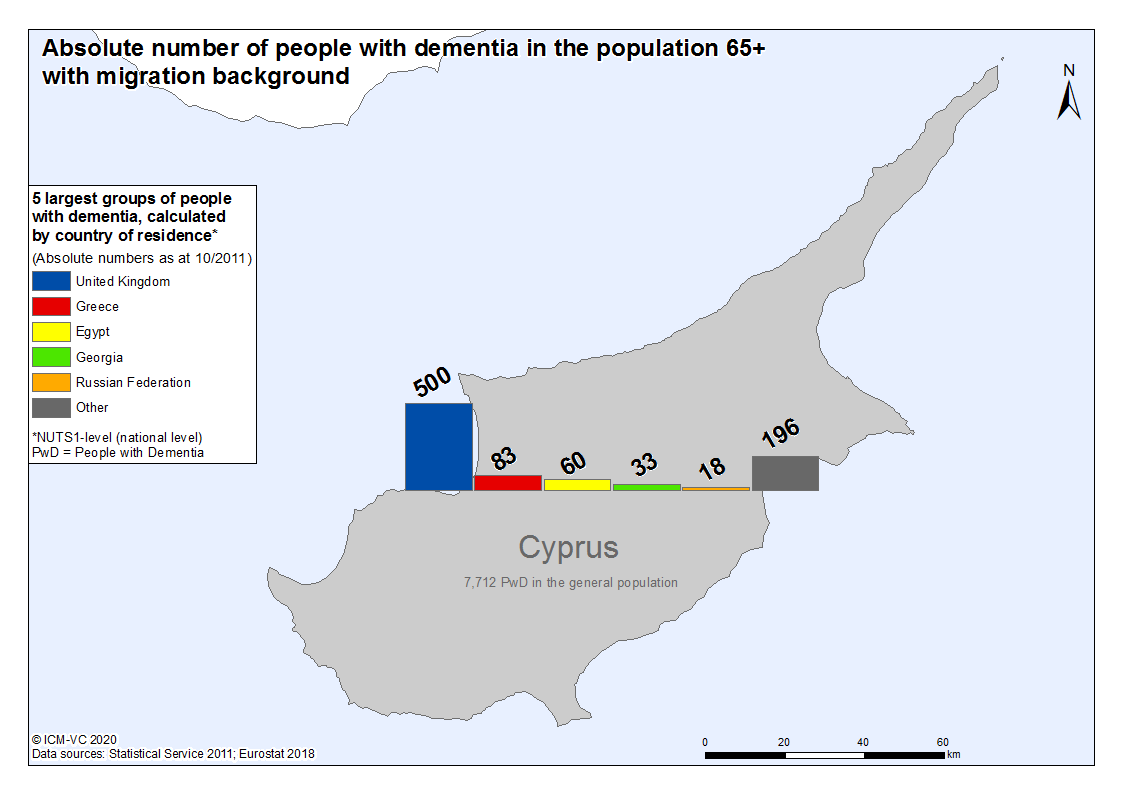EU-Atlas: Dementia & Migration
| Largest group | 2. largest group | 3. largest group | 4. largest group | 5. largest group | |
| Absolute numbers | |||||
| PwMD per 100,000 inhabitants 65+ |
| Absolute numbers | PwMD per 100,000 inhabitants 65+ | |
| Largest group | ||
| 2. largest group | ||
| 3. largest group | ||
| 4. largest group | ||
| 5. largest group |
| Prevalence per 100,000 inhabitants 65+*, calculated by country of residence | |||
|---|---|---|---|
| high > PwMD |
minor > - PwMD |
||
| increased > - PwMD |
low ≤ PwMD | ||
| medium > - PwMD |
|||
| PwMD = People with a Migration background with Dementia *Bulgarien, Litauen, Malta, Polen in der Bevölkerung 60+ |
|||
| Absolute number of PwMD 65+ | |
| PwMD per 100,000 inhabitants 65+ |
Cyprus
Cyprus has a long history of migration. After being more characterized by emigration since people trying to find jobs abroad and due to the violent clashes between Greek and Turkish Cypriots1,2, Cyprus developed into a country of immigration due to the collapse of the Soviet Union, changes in policies, and the recent refugee crisis1,3. Between 1990 and 2019, the migrant population (born abroad) more than quadrupled (43,800 to 191,900) and the migrant proportion of the total population almost tripled (5.7 to 16%)4.
There are 12,900 people with a migration background aged 65 or older. Of those, approx. 900 are estimated to exhibit some form of dementia. Calculations show the most affected migrant groups presumably originate from Great Britain (approx. 500), Greece (approx. 80), Egypt (approx. 60), Georgia (approx. 30), and the Russian Federation (approx. 20)5.
The ‘National Action Plan for the Treatment of Dementia in Cyprus 2012-2017’ from 2012 has no separate chapter on migration but refers briefly to this topic in two sections. First, it is pointed out that ethnicity is a risk factor for dementia, as well as age and gender. In addition, the national strategy commits to the values of equal access to diagnostic tests, treatments, medicines, and care without discrimination on the basis of gender, age, ethnicity, and origin. Overall, the topic of migration plays a marginal role in the national action plan for the treatment of dementia6. According to the National Ministry of Health, Cyprus does not have a document with national treatment guidelines for dementia7.
References
- Demetriou O: Migration into the Cyprus conflict and the Cypriot citizenship regime. In.: PRIO Cyprus Centre; 2019.
- Gregoriou P, Kontolemis Z, Matsi M: Immigration in Cyprus: An Analysis of the Determinants. Cyprus Economic Policy Review 2010, 4(1):63-88.
- Trimikliniotis N: Racism and New Migration to Cyprus: the Racialisation of Migrant Workers. In: Into the Margins: Exclusion and Migration in Southern Europe. edn. Avebury: Anthias, Flazarides, G; 1999.
- International Organisation for Migration: International migrant stock as a percentage of the total population at mid-year 2019: Cyprus. In., 18.09.2019 edn; 2019.
- Statistical Service: Census of Population 2011. In. Nicosia: Statistical Service; 2011.
- Ministry of Health: National Action Plan for the Treatment of Dementia in Cyprus 2012-2017. In.: Ministry of Health 2012.
- Ministry of Health Cyprus: National treatment guideline for dementia. In., E-mail Conversation edn; 2019.


![[Translate to Englisch:] Logo RBS [Translate to Englisch:] Logo RBS](/fileadmin/_processed_/9/7/csm_RBS_Logo_RGB_0e245a98a4.jpeg)